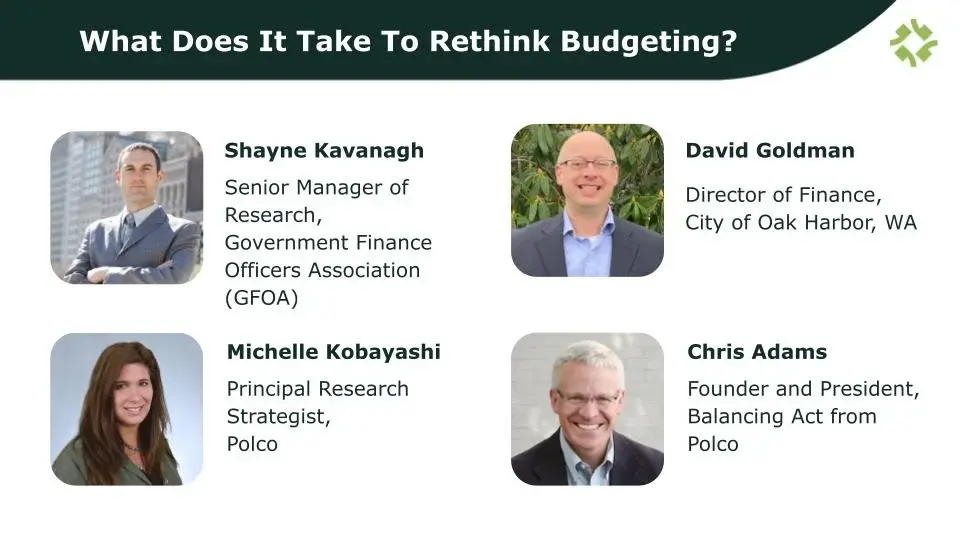What Does It Take to Rethink Budgeting?
By Polco on October 19, 2023

Government officials discuss the current state of budgeting and whether they are ready to modernize existing processes.
There is a growing awareness that local government budgeting practices need updated. Many local governments recognize the limitations of traditional budgeting methods and are eager to explore new approaches. However, there are challenges and barriers to implementing these changes, such as entrenched thinking, limited resources, and lack of support from leadership.

With other government technology leaders Euna and Envisio, Polco launched the "Local Government Budget Survey" to find out where organizations currently stand with their budgeting processes. Are budget officers prepared to update their methods? Have they already started? This survey was initially distributed among the Government Finance Officers Association (GFOA) member base.
The survey results add deeper insight to GFOA’s Rethinking Budgeting initiative, a blueprint for how to make the most of limited budgets to solve complex problems.
In this webinar, finance and survey science leaders discuss the survey results and concerns with budgeting practices today.
What is the Current State of Budgeting?
 Shayne Kavanagh, Senior Manager of Research at GFOA, said the present-day budgeting process faces three main criticisms.
Shayne Kavanagh, Senior Manager of Research at GFOA, said the present-day budgeting process faces three main criticisms.
Criticism 1: Decisions are frozen in place
“Last year's budget became next year's budget,” Kavanaugh said. Rolling over budgets from year to year particularly becomes an issue when funding comes from grants. Those funds become part of an organization's baseline budget, even after the grant funding ends.
Criticism 2: The traditional budget is not strategic
Many organizations allocate spending to line items and day-to-day operational concerns. And line items don’t typically impact big-picture results in areas that matter most, such as public safety, mobility, and public health.
Criticism 3: Traditional budgeting is a zero-sum game
A zero-sum game in budgeting means that for one department to get more funding, some other departments must get less. This creates competition instead of collaboration.
In addition, a Pew Research study revealed that 85% of Americans say the political systems need updating. The Rethinking Budgeting Initiative is a response to the notion that people want their governments to improve.
The challenge is there are more complex problems than ever, such as housing and climate change. Currently, Kavanagh says, many local governments give modest budget increases to each of these departments, making it difficult to make big changes.
A zero-sum game mentality makes things worse.
“If you're involved in a win-lose game, it's going to be hard to come up with a solution that really addresses all of the mutual accommodations that are going to need to be made in order to deal with a complex problem and overcome that conflict,” he said.

GFOA developed and proved The Financial Foundations Framework to overcome these criticisms and threats. They based the framework on a Nobel Prize-winning theory on how to maintain limited environmental resources. The theory was applied to government budgeting and then tested with pilots, research, and incubator programs. (To see the steps outlined in the framework, visit gfoa.org/financial-foundations.)
"This work we're doing here with Polco is really part of now bringing a lot of these conversion ideas together into a coherent package that can be used by local governments to advance the way they do budgeting,” Kavanagh said.
What Local Government Finance Leaders Think of Budgeting Processes Today: GFOA Member Survey Results
To move forward with the Rethinking Budgeting initiative, Polco surveyed GFOA members to find out their thoughts on budgeting processes today.
It’s important to note that GFOA members are often higher performing. While the results include looking at national data, they are from the country’s leaders in local government budget and finance.
Highest Scoring Areas of Budgeting
- Incorporating the values and opinions of elected officials
- Providing good value on services to taxpayers
- Useful for day-to-day management of operations
- Relying on clear financial rules related to reserves and one-time revenues
Lowest Scoring Areas of Budgeting
- Facilitating resident understanding of the budget process
- Distributing resources to disadvantaged groups
- Allowing residents to help in the decision-making of important trade-offs
Highest Scoring Areas in Budgeting Organizational Culture
- Transparency with internal stakeholders
- Transparency with the public
- Fostering a trusting relationship between elected officials and staff
Lowest Scoring Areas in Budgeting Organizational Culture
- Welcoming resident involvement in decision-making
- Being outcome-results focused
- Using strategic plans to guide the budget
Highest Scoring Areas in Budgeting Tools
- Interest in adopting new technology
- Having adequate procurement policies in place to purchase new technology
Lowest Scoring Areas in Budgeting Tools
- Flexibility of your current system to accommodate new technology
- Employing a systematic approach to new technology adoption
- Resources dedicated to staff training on new technology
- Resources dedicated to purchasing new technology

How do the people in your organization affect the ability to evolve your budget practices?
5 in 10 say the biggest barrier was entrenched thinking by longtime employees.
4 in 10 say resources dedicated to staff training and hiring, limited power of budget staff to influence organizational decision making, and existing knowledge and staff skill sets are barriers.
3 in 10 say lack of knowledge from current leadership on budgeting and lack of support from leadership to change current budgeting practices are barriers.
Diving Deeper into the Current State of Budgeting Survey Results
Finance Director David Goldman from Oak Harbor, Washington, analyzed the data to find out more about what it means. He discovered that about 28% of the respondents are currently practicing advanced budgeting techniques. He also found out what contributed most to readiness to change budgeting practices.
Factors Influencing Readiness
- Resident satisfaction with the current budgeting methodology process
- Organizational use of data in decision-making
- Welcoming resident involvement in decision-making
- Organizations that adapt well to change
- Employing a systematic approach to new technology adoption

“Since these are the key driving factors, it might make sense for organizations to think about these things when they're on the path to rethinking their budget process,” he said.
He said organizations can ask themselves how the public is currently involved in their city's budget process. He says governments can implement something simple increase participation and transparency then continue to move toward a more robust process over time.
“I find that one of the hardest things to do when it comes to changing things such as budgeting is taking the first steps,” Goldman said. “Oftentimes what ends up holding [organizations back] when they thinking about the the way to do budgeting is just answering a simple question—why should we change…?”
Get Exclusive Access to More Budgeting Resources
Streamline your governments budgeting processes with more Rethinking Budgeting resources. Get tips from budgeting leaders, exclusive budgeting data, and much more!
Related Articles
Popular posts
Sign-up for Updates
You May Also Like
These Related Stories

Missed Opportunities To Build Trust in Local Government Budgeting

Transforming Public Finance: Embracing Rethinking Budgeting Principles



